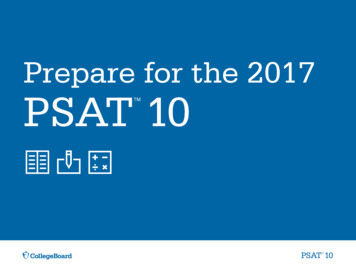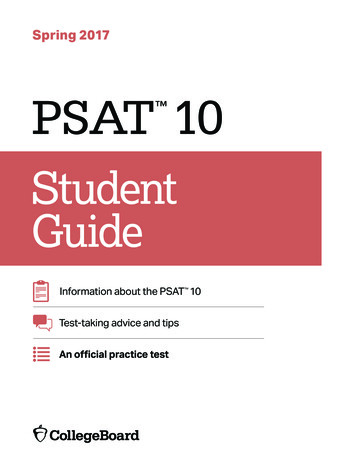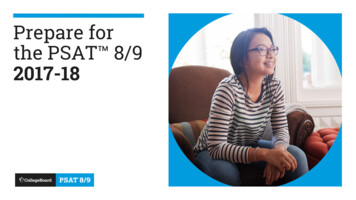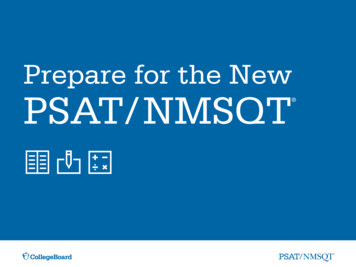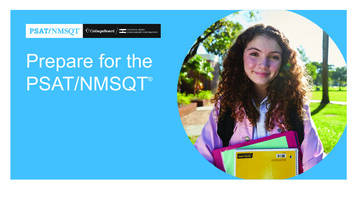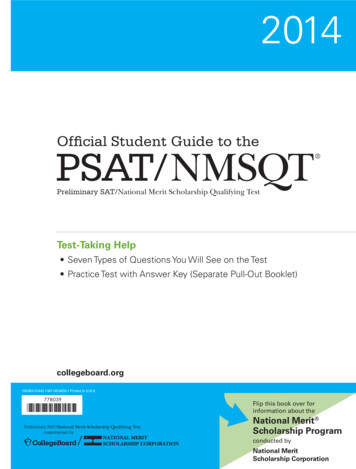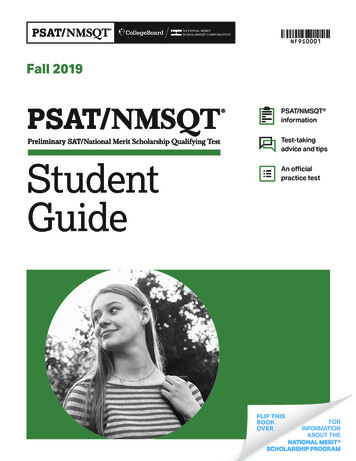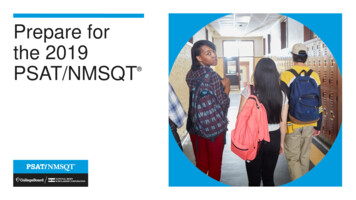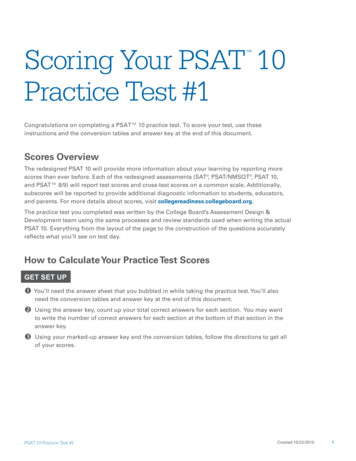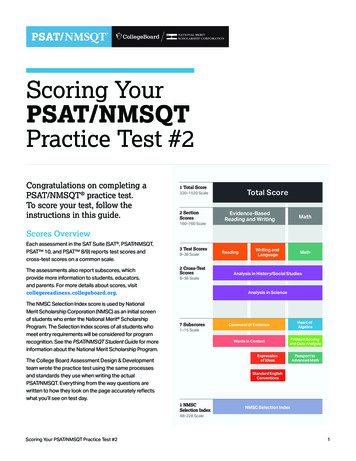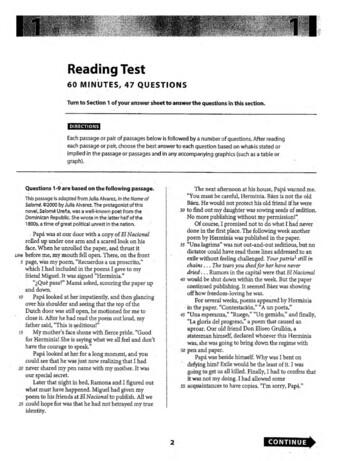
Transcription
, .·Reading Test60 MIN.U TES, 47 QUESTIONSTurn to Section 1 of your answer sheet to· answer the questions in this section. MH M HEach passage or pair of passages below is followed by a number of questions. After readjngeach passage or pair, choose the best answerto each question based on what-is stated orimplied in the passage or pas.sages and in any accompanying graphics (such as a table orgraph).Questions 1 9 are based on the following passage.This passage is adapted from Julia Alvarez, In the Name ofSalome. 02000 by Julia Alvarez. The protagonist of thisnovel, Salome Urena, was a well-known poet from theDominican Republic. She wrote in t he latter half of the1800s, a time of great political unrest in the nation.30. Papa was at om: door with a copy of El Nacionalrolled up under one arm and a scared look on hisface. When he unrolled the paper, and thrust itune before me, my mouth fell open. There, on the front5 page, was my poem, "Recuerdos a un proscrito,".which I had included in the poems I gave to myfriend Miguel. It was signed "Herminia.""i Que pasa?" Mama asked, scouring the paper upand down.10Papa looked at her impatiently, and then glancingover his shoulder and seeing that the top of theDutch door was still open, he motioned for me toclose it. After he had read the poein out loud, myfather said, "This is seditious!"15My mother's face.shone with.fierce pride. "Goodfor Herminia! She is saying what we all feel and don'thave the courage to speak."Papa looked at her for a long moment, and youcould see that he was just now realizing that I had20 never shared my pen name with my mother. It wasour special secret.Later that night in bed, Ramona and I figured outwhat must have h appened. Miguel had given my. poem to his friends at El Nacional to publish. All we25 could hope for was that he had not betrayed my trueidentity.35The next afternoon at his house, Papa warned me."You must be careful, Herminia. Baez is not the oldBaez. He would not protect his old friend if he wereto find out my da½ghter was sowing seeds of sedition.No more publishing without my permission!",Of course, I promised not to do what I had neverdone in the firs place. The following week anotherpoem by Herminia was published in the paper."Una lagrima" was not out-and-out seditious, but nodictator could have read those lines addressed to anexile without feeling challenged. Your patria1 still inchains . The tears you shed for her have neverdried·. . Rumors in the capital were that El Nacionalwould be shut down within the week. But the papercontinued publishing. It seemed Baez was showingoff how freedom-loving he was. .For several weeks, poems appeared by Herminia- in the paper. "Contestaci6n," "Aun poeta,"45 "Una esperanza,". "Ruego," "Un gemido," and finally,"La gloria del progr eso," a poem that caused anuproar. Our old friend Don Eliseo Grullon, astatesman himself, declared whoever this Herminiawas, she was going to bring down the regime withso pen and paper.Papa was beside himself. Why was I bent ondefying him? Exile would be the least of it. I wasgoing to get us all killed. Finally, I had to confess thatit was not my doing. I had allowed some55 acquaintances to have copies. ''I'm sorry, Papa."402CONTINUE
But secretly, I was glad. Poetry, my poetry, waswaking up the body politic! Instead ofletting myfather's fears hold me back, I kept writing bolderpoems.60Sometimes my hand would shake as I wrote.Herminia, Herminia, Herminia, I would whisper tomyself She was the brave one. She was not in thrallto her fears. She did not quail at a harsh word . Or tocry over every little thing, wasting her tears.65Secretly, in the dark cover of the night, Herminiaworked at setting la patria free.And with every link she cracked open forla patria, she was also setting me free.3Which choice provides the best evidence for theanswer to the previous ·question?A) Lines 3-4 ("When . open")B) Line 15 ("My . pride")C) Lines 20-21 ("It . secret")D) Lines 51-52 ("Why . him")41 homelandIt can reasonably be inferred that Papa's "scaredlook" (line 2) is caused by his concerns about4A) his friends' and neighbors' opinions.B) his family's safety and well-being.Which choii;e best summarizes the passage?C) the relationship between the narrator and hermother.A) A catastrophic eyent occurs, and the resultingdisorder i.S analyzed.D) the narrator's desire to become a writer.B) A painful confession is made, a:nd several doserelationships unravel.5C) A long-standing commitment is broken, and aseries of repercussions follows.Which choice provides the best evidence for theanswer to the.previous question?D) An unexpected discovery is made, and the eventsoccurrine: after that discoverv are described.A) Lines 10-13 ("Papa . close it")B) Lines 13-14 ("After . seditious")C) Lines 18-20 ("Papa . . ·mother")2D) Lines 52-53 ("I . killed")· What does the p'3.ssage suggest about how. Paparelates to the narrator compared to how Mamarelates? ·A) · Papa is a stricter disciplinarian with the narratorthan Mama is.As used in line 8, "scouring" most nearly means. A). searching.B) Papa is more privy to the narrator's confidencesthan Mama is.B) eroding.C) Papa is more complimentary of the narrator'spoetry than Mama is.D)C) purging.wavine:.D) Papa is more tolerant of the narrator's rebelliousnature than Mama is.3CONTINUE
Questions 10-18 are based on the following .·passage and-supplementary material.7As used ii?'. line 15, "fierce" most nearly meansThe passage is adapted from Joshua Gowin, "Nature'sBounty: Meet Your Maker." 2009 by Psychology Today.A) distressing.B). struggling.From the beginning of the agricultural age to themid-twentieth century, the majority of our foodcame from local farms, Following the Second WorldLine War, the mass cultivation of durable produce in a5 few locations enabled distributio n countrywide to. warehouse-like supermarkets. Food shoppingbecame a less frequent event, driven largely by priceand other "rational" economic considerations.Over several decades, taste and quality-and,10 eventually, nutrition and food safety- were sacrificedto efficiencies of production, including producemonoculture, which weakened crop health. As foodanthropologist AmyTnibek points out, America ·produces a great array of potato chips but only a few15 varieties of potato.·At some point-perhaps when antibiotics wereneeded to counter the effects of mass housing ofanimals-the efficiencies gained by industrializationbegan yielding diminishing returns. Today, recalls of ·20 contaminated meat and, produce occur with alarmingfrequency.More subtly, however, industrial farmingruptured the rich web of cultural experiencestraditionally tied to food-conviviality, a sense of25 connection, knowledge of food vendors, trust in theprovenance of food, and links to the pastIncreasingly, consumers crave the personal touch infood shopping and see farmers markets as the way t restore it.30Geographer Robert Feagan surveyed a hundredshoppers at a farmers market in Ontario, Canada.He found that despite having only moderate income,the shoppers were not deterred by the slightly higherprices of farmers markets. When it comes to food,35 value proves to involve much more than sheer price.Nor did Feagan's consumers fully endorseenvironmental matters like organic production orconcerns about how far their food had to travel,although such factors are often.touted as prime40 reasons for shopping at farmers markets.However noble, the abstract reasons are not asmouthwatering as more palpable factors like socialengagement and fresh flavor.C) intense.D) hostile.8The italicized words in lines 37-39 serve mainly to· A) convey the lyrical cadence of Herminia's words.B)illustrate the defiant nature of Herminia's poetry.C) represent the urgent wishes of Dominican exiles.ID) demonstrate the uplifting effects of patrioticverse.9The main purpose oflin s 56-68 is toA) ·convey the kind of inspiration the narratorrequires to help her write poetry.B) demonstrate the inhibiting impact that Papa'swords have had on the narrator".C) provide a sense of foreboding about theinfluence that the narrator's poems-may have.D) reveal the effect that the publication of herpoems has had on the narrator.4CONTINUE
"Ifs fresh produce, it's local, especially in the ··summertime," says one shopper. "And I like theambience, I like the atmosphere. It's very personal.It's about being healthy. You're buying healthier foodbecause it's directly from the field." ."It's the whole social aspect, and the culture of50 eating," says another."We know a lot of the vendors," another shoppertold Feagan. "And there is interesting interaction,and you are able to talk to them while you're buyingyour food--:it makes them part of your life. It's a55 social activity, just a great experience.""Supermarkets are busy places that aren'tconducive to conversations," says -Feagan, a professorof contemporary studies at Wilfr,id LaurierUniversity in Brantford, Ontario. Indeed, sociologists60 have found that patrons have ten times moreconversations in farmers markets than in. conventional supermarkets.Farmers are enjoying the resurgence of direcimarketing,. too. It pro.vides regular income. Many65 build loyal followings and are able to field andrespond to direct consumer requests.Shopper interaction with food producers can alsosweeten the experience of eating. Farmers are oftengood sources of tips for simple but scrumptious food70 preparation. The predominance of fruits andvegetables- as compared to conventionalmarkets-encourages consumption of foods thaboost health and protect against such chronicdiseases as 9iabetes and heart disease.45Figure 1United States Farmers Market Growth, 00.0Cl)2,000. J 1,0000199419961998200020022004200620082009Adapted from USDA, Agricultural Marketing Service, Farmers Market Survey.5CONTINUE
Figure2Consumers' Ratings of the Importance of Various Factorsin Deciding Whether to Shop at a Farmers Markettop-quality products3.80minimal chance of food-borne illness3.75products support local farmsII3.71111'.i. good value location is convenient,I3.50itat ·. ,:3.44.1-l,!;Ihours of operation are convenient·. ,;:;,, ,., .3.40Ilarge variety of products available3.38;tl, '.l@'-Iwelcoming atmosphere3.25Iinfo. available on how food was grown- :·& . ·can do all shopping in one place0I· ,.: hormone- and antibiotic-free products '" ;!"e:;i,;S;I .1ll]averageimportance3.19 .3.08I3.07' l!L3241 not important at all3 somewhat important2 not very important4 very importantAdapted from David Conner et al., "Locally Grown Foods and Farmers Markets." Cl2010 by Sustainablllty.In line 8, the author places the wor d "rational" inquotes toAccording to the passage, the industrialization 'offood production has recently led to an increase in theA) imply that the usage of the word in this instanceis a matter of understatement.A) availability of fresh foods. ,B) risk of food-borne illness.·13) indicate that a particular assertion will later bedisproved.C) number of food producers.D) nutritional value of food.C) suggest th a t seemingly reasonable decisions .overlooked important fact?rs.D) emphasize the importance of evidence-basedresearch to economists.12Which choice provides the best evidence for theanswer to the previous question?A) Lines 3-6 ("Following . . supermarkets")BJ Lines 16-19 ("At . returns")C) Lines 19-21 ("Today . frequency")D) Lines 22-26 ("More . . past")6CONTINUE
17The author indicates that the cost of food in farmersmarketsWhich statement from the passage is best supportedby figtiie l?A) · is typically greater.than the cost of food in othertypes of markets.A) Lines 1-3 ("From . farms")] ) compares favorably to that of food that ismass-produced.B) Lines 9-12 ("Over . health")TextC) Lines 27-29 ("Increasingly . it")D) Lines 34-35 {"When . price")C) is low considering the food's superior quality.1D) has graduallr risen over time.Figure 2 provides support for which point made inthe passage?Which choice provides the best evidence for theanswer to the previous question?A) The nutritional value of food sold at farmersmarkets is greater than that of food sold attraditional supermarkets.A) Lines 32-34 ("He . . markets")B) Lines 41-43 ("However . . . flavor")B) Environmental concerns are not the primaryreason that consumers patronize farmers·markets.C) Lines 63-64 ("Farmers . too")D) Line 64 ("It . income")C) Getting a good value is more important toconsumers than is supporting local farmers.15· D) Finding products that are free of hormones andantibiotics is the primary reason that consumersshop at farmers markets.· :As u sed in line 35, "sheer" most nearly meansA) insubstantial.B) genuine.C) simple.D) clear.16· As used in line 64, "regular" most nearly means- A) common. B) stereotypical.C) steady.D) generous.7CONTINUE
,:"f.r. .-. t··-- .,,. .,,.rewar4 the dog with the food from the plate. Initially,all the animals attempted in vain to reach the food.However, by the second minute of testing, dogsbegan to look towards the humans. This increasedover time and by the fourth minute there was astatistical difference. Dogs were more likdy to50 initiate eye contact with the human experimenterthan the wolves were. This is no small feat; initiating .eye contact with the experimenter requires that theanimal refocus its attention from the food to thehuman. Not only did the wolf pups.not55 spontaneously initiate eye contact with the humanexperimenter, but they also failed to learn that eyecontact was the key to solving their problem.(See figure L).A second experiment, conducted when the wolves60 and puppies were between four and eleven monthsold, found similar results. Each animal waspresented, in different testing sessions, with two ·different types of tasks. First, each of the wolves anddogs was trained to retrieve a food reward by·65 opening a bin (in one task) or pulling-a rope (in thesecond task). Then, after they had mastered the task,they were presented with an impossible version ofthe same problem. After attempting to retrieve thefood, the dogs looked back towards the human70 caregivers. The wolves d no such thing. pogs·spontaneously initiated a communicative interactionwith the humans earlier, and maintained it for longerperiods oftime, than did the human-reared wolves,which all but ignored their human caregivers.75 (See figure 2.).· Both dogs and wolves were equally adept at ·learning the two tasks, indicating that there were nogroup differences in terms of motivation or p ysicalabilities, but large differences emerged when givenso impossible problems to solve. In both impossibletasks, as well as in the earlier eye contact experiment.dogs instinctively shifted their attention away fromthe food and towards the humans. Despite the.factthat they had been fully socialized, the wolves treated85 each of the situations as physical problems ratherthan social ones. Only rarely did they ever attempt toengage in a communicative problem-solvinginteraction with a human. It's not that wolves are·unintelligent; it's quite the opposite, in fact. Wolvesoo are cooperative hunters, skilled at negotiating within. their own social networks.Questions 19-28 are based on the followingpassage and supple'!1entary material.45This passage Is ·adapted from Jason G. Goldman, "Dogs, ButNot Wolves, Use Humans As Tools." 2012 by Jason G.Goldman.Several years ago, scientists at Eotvos Universi in Budapest wanted to determine whether thesocial-cognitive differences between dogs and wolv sUn were primarily genetic or experiential. To do this,s they hand-raised a group of dog puppies and a groupof wolf pups from birth. resulting in roughlyequivalent experiences. Any differences between thetwo groups' social-cognitive skills, then, would beattributable to genetics.10Wolf and dog pups were·raised by humansstarting four to six days after birth, before their eyeshad fully opened. For the first months of their lives,the wolf and dog pups were in close contact withtheir human foster parents nearly twenty-four hours· 15 per day. They lived in the homes of their caregiversand slept with them at night. They were bottle-fed,and starting on the fourth or fifth week of life, handfed with solid food. Their human caregivers carriedthem in a pouch so that the wolf pups and dqg20 puppies could participate in as much of their dailyactivities as possible: traveling on publictransportation, attending classes, visiting friends, andso on. Each-of the pups had extensive experiencemeeting unfamiliar humans, and at least twice a2s week, they w ere socialized with each other as well aswith unfamiliar adult dogs. The guiding principle for· the hand-rearing paradigm, according to the· researchers, was based not upon competition oraggressive interactions. but "to behave rather like a30 mother than a dominant conspecific [member of thesame species]."Would wolves, having been raised by humans,demonstrate social-cognitive skills thatapproached the sophistication of dogs? Or is35 social-cognitive aptitude encoded in dogs' genes,a direct result of domestication?In one simpl task, a plate of food was presentedto the wolf pups (at 9 weeks) or to the dog puppies(both at 5 weeks and at 9 weeks). However, the food40 was inaccessible to the animals; human help wouldbe required to access it. The trick to getting the foodwas simple: all the animals had to·do was make eyecontact with the experimenter, and he or sh would8CONTINUE
Figure 1."' 12uWhich choice best reflects the overall structure of thepassage?0A) A discussion of a scientific premise is followed·by a challenge to that premise.,-.C:s"' ."'C: ro- u 8.s 6.c::II)II).II)4-c"' .D. ,B)40II)report of that investigation's results.2II) §C:-----0-------.!I.C) A consideration of an abstract theoryis followedby an application of that theory.0IU firstminutesecondminute- - dogs, 5-week-old- - wolves, 9-week-oldthirdminutefourthminuteD) An observation of a natural phenomenon is ,followe·d by an.analysis of that phenomenon.-o- dogs, 9-week-oldWhich choice is an underlying assumption of theexperiments p.escribed in the passage?Figure2A) If dogs and wolves meet people early in life, theywill be able to learn new skills later in life.·[ 120bl) 0 100 .9 80II)B) If dogs and wolves see people as soon as theyopen their eyes, both species will rely on peoplemore than they rely on other animals.D A description of an investigation is followed by a60 'Sii"' 40g. "'u.- 20C) If dogs and wolves are not well socialized topeople, both species will behave aggressivelywhen competing for food.§ ;D) If dogs and wolves have similar experienceswhen they are young, then different behaviorlater mtist necessarily be innate.E- 0-'-------------dogswolvesD bin tasklit] rope taskIn figure 2, the boxes represent the middle 50 percent ofelapsed times, and the thick horizontal lines represent themedian elapsed times (up to a maximum of 126 seconds).The dashed line indicates that the wolves did not respondto the bin task within 120 seconds.Which choice provides the best evidence for theanswer to the previous question?A) Lines 1-4 ("Several . experiential")B) Lines 7-9 ("Any . genetics")Figure 1 adapted from Marta Gacsi et al., "Species-SpecificDifferences and Similarities in the Behavior of Hand-Raised Dog andWolf Pups in Social Situations with Humans." 2005 by WileyPeriodicals, Inc.·. Figure 2 adapted from Adam Mlkl6si et al., "A Simple Reason for aBig Difference: Wolves Do Not Look Back at Humans, but Dogs Do." 2003 by Elsevier Science Ltd.·C) Lines 1o 12 ("Wolf . . . opened")D) Lines 12-15 ("For . day")·9CONTINUE
-As used in line 10, "raised" most nearly meansWhich choice best supports the claim that wolvespossess as much aptitude for acquiring new skills asdogs do?A) elevated.fiJ·, builtA) Lines 54-57 ("Not only . problell:1")C) restored. .B) Lines 66-68 ("Then . problem")-: .C5 Lines 76-80 ("Both . . solve")D) reared.D) Lines 86-88 ("Only . human")The primary purpose of the third paragraph(lines· 32-36) is to·What main purpose do figure 1 and figure 2 serve inrelation to the passage as a "{hole?A) offer alternative solutions.;:foin dicate competing hypotheses.A) They illustrate the results of differentexperiments discussed in the passage.C) describe divergent goals.D) .explain contradictory arguments.B) They reconcile the outcomes of differentexperiments described in the passage.,-C) They expand on a set of findings touched uponbriefly in the passage.A .used in line 34, "approached" most nearly meansD) They provide·alternative explanations for dataanalyzed in the passage.A) approximated.B) presented.C) advanced.D) followed.m tttt:/ ::?{:.:::,:::: :.k:f-/;···):t ::,'. :; ::: .:; :.f; ? ililrli\Based on the information in the passage and infigure 2, the dogs in the second experiment, ingeneral, wereA) more likely to solve the rope task than thebin task.It can reasonably be inferred that one of theexperimenters' goals in socializing the wolf and dogpups was to encourage theirB) stymied more quickly by the rope task t an theywere by the bin task.A) ability to master puzzles given to them bypeople.C) quicker to attempt solutions not involvinghumans for the rope task than for the bin task.B) development as docile companions of people.D) slower to show affection for their caregiversduring the bin task than during the rope task.· C) sense of comfort with and around people.D) desire to receive rewards from people.10CONTINUE
Questions 29-38 are based on the followingpassage.The following passage is adapted from Frederick Douglass,"What to the Slave Is the Fourth of July?" Originallydelivered on July 5, 1852. Douglass, a noted abolitionist andauthor, was a former slave. He 9!1V this speech to anantislavery group in Rochester, New York.sacrilegi0us irony. Do you mean, citizen , to mockrFellow-citizens, pardon me, allow me to ask, whyam I called upon to speak here to-day? What have I,or those I repres nt, to do with your national.independence? Axe the great principles of politicals freedom and of natural justice, embodied in thatDeclaration of Independence, extended to us? andam I, therefore, called upon to bring our humbleoffering to the national altar, and to confess thebenefits and express devout gratitude for the10 blessings resulting from your independence to us?Would to God, both for your sakes and ours, thatan affirmative answer could be truthfully returned tothese questions! Then would my task be light, andmy burden easy and delightful. For who is there so1s cold, that a nation's sympathy could not warm him? ·Who so obdurate and dead to the claims of gratitude,that would not thankfully acknowledge such pricelessbenefits? Who so stolid and selfish, that would notgive his voice to swell the hallelujahs of a nati n's20 jubilee, when the chains of servitude had been tomfrom his limbs? I am not that man. In a case like that,the dumb might eloquently speak, and the "lameman leap as an hart."1But, such is not the state of the case. I say it with a2s sad sense of the disparity between s. I am notincluded within the pale of this glorious anniversary!Your high independence only reveals theimmeasurable distance between us. The blessings inwhich you, this day, rejoice, are not enjoyed in30 common. - The rich inheritance of justice, liberty,prosperity and independence, bequeathed by yourfathers, is shared by you, not by me. The sunlightthat brought life and healing to you, has broughtstripes and death to me. This Fourth [of] July is35 yours, not mine. You may rejoice, I must nioum.To drag a man in fetters into the grand illuminatedtemple ofliberty, and call upon him to join you injoyous anthems, were inhuman mockery andLine40 me, by asking me to speak to-day? If so, there is aparallel to your conduct. And let me warn you that itis dangerous to copy the example of a nation·whosecrimes, towering up to heaven, were thro down bythe b'reath of the Almighty, burying that nation in45 irrecoverable ruin! I can to-day take up the plaintivelament of a peeled and woe-smitten people!"By the rivers 9f Babylon, there we sat down. Yea!we wept when we remembered Zion. We hanged ourharps upon the willows in the midst thereof. Forso there, they that carried us away captive, required ofus a song; and they who wasted us required of us·mirth, saying, Sing us one of the songs of Zion . Howcan we sing the Lord's song in a strange land? IfI .fo rget thee, 0 Jerusalem, let my right hand forget he ss cunning. Ifl do not remember thee, let my tonguecleave to the roof of my mouth."2Fellow-citizens; above your national, tumultuousjoy, I hear the mournful wail of millions! whosechains, heavy and grievous yesterday, are, to-day,60 rendered more intolerable by the jubilee shouts thatreach them. If I do forget, ifI do not faithfullyremember those bleeding children ofsorrow this day,"may my right hand forget-her cunning, and may mytongue cleave to the roof of my mouth! To forget65 them, to pass lightly over their wrongs, and to chimein with the popular theme, would be treason mostscandalous and shocking; and would· make me areproach before God and the world. My subject, thenfellow-citizens, is AMERJCAN SLAVERY. I shall see,70 this day, and its popular characteristics, from theslave's point of view. Standing, there, identified withthe American bondman,3 making his wrongs mine, Ido not hesitate to declare, with all my soul, that thecharacter and conduct of this natio never looked75 blacker to me than on this 4th ofJuly!1 In this quotation from the Bible, a "hart" Is a type of deer.2 This quotation from-Psalm 137 in the Bible describes theexperiences of Jewish exiles in the city of Babylon.3 A "bondman is an adult male slave.11CONTINUE
The primary purpose of the p;issage is toWhich choice provides the best evidence for theanswer to the previous question?A) propose an approach to achieving a political·change.A) Lines 18-21 ("Who so . . limbs"),. ;,-:-,B) question the wisdom of celebrating the id eals ofan earlier generation.\B) , Lines 27-30 ("Your· . common")C) Lines 41-45 (''And let . ruin")C) · explain the ethical values underlying a nationalholiday.D) Lines 68-69 ("My subject . SLAVERY")D) contrast revered political principles with socialreality.Douglass indicates that expecting him to celebratethe Fourth of July is A) ironic given his hostility to the ideals that theholiday honors.The questions in the first paragraph primarilyserve toB) satisfying in light of the fact that he achieved hisfreedom through his own efforts. ) explore an ideal that Douglass will abandon.B) reveal a m otivation that Douglass will analyze.C) insulting to both him and the values beingcelebrated.'c) -raise a possibility.that pouglass will discredit.b) summarize a claim that Douglass will endorse.D) upsetting to people who do not- believe that he istheir equal.In the context of the passage as a whole, the phrases"pardon me" and "allow me to ask" (line 1) serveprimarily toWhich choice provides the best evidence for theanswer to the previous question?A) project an appearance of courtesy.A) Lines 24-25 ("I say . . us")B) demonstrate private respect and public mistrust.B) Lines 36-39 ("To drag . irony")C) ;lemand close attention from the audience.C) Hoes 55-56 ("Ifl . mouth")D} e courage curiosity and compassion.D) Lines 69- 71 ("I shall . view")Douglass makes which point about the Fourth of Julyholiday?A significant contrast that Douglass draws betweenhimself and his audience is that heA) It gives him a profound feeling of national pride.A) refuses to rejoice in the country's freedoms whilethose freedoms are denied to slaves.B) · It should not be celebrated while slavery. continues to exist.B) thinks the holiday should memorialize thenation's founders.C) It impresses upon him the disparities betweenthe lives of different groups-within theUnited States.,,C) -questions the value of the United States'founding principles.D) It inspires him to work hard to eliminate slaveryso that the country can live up to its ideals.D) believes that slavery is a moral issue, not merelya political one.12CONTINUE
IIBL" n Ai. .i - t - 51. :k 'iamIn ayingnot th t an,; (lin 21),suggests that he· 'A)b s;'1·,; :; . ·could not resist a joyful' feeling of patriotism ifhe. As used fa Hi\e' J4; "statit most-in at1y··m'e'ans ?,--.i . A) : U6i·.· : .-B) rank.c).:: h lihon.enjoyed equality with his audience,''\. IB) could not explain the Fourth of July holiday tothose-who remail;l enslaved. ·: D) imp rative.· C) is not motivated by self-interest when addr ssingthe audience on the Fourth of July.· · ·D) is professing beliefs on this occasion that he.hassuppressed in the past.i:iCONTINUE
the coastal live oak, and the mutualistic associationseems to benefit both the lichen and the host trees.The lichen benefits from the structur·e d space andmicroclimate created by the oak canopy. The·45 California valley oak and the blue oak arewinter-deciduous white oaks that differ slightly inbark texture. The California valley oak is usuallyfound in valleys, while the blue oak occurs morecommonly on the adjacent'slopes. The coastal live50 oak, an evergreen oak belonging to the black oaksgroup, does not have strong habitat preferences. Thisspecies has a very dense canopy and smoother barktextures than the white oak species. In Californianinland localities, such as our study area, R. menziesii55 grows mostly during the winter season, and winterrainfall provide·s most of its water. Thus, in theseinland localities, the deciduous.oaks may b e a morebeneficial substrate during the growing season of R.menziesii because they shed their leaves in winter,60 allowing ample light for the lichen's phototroph. Incontrast, light may be a limiting factor forphotosynthesis of R. menzies
Reading Test 60 MIN.UTES, 47 QUESTIONS Turn to Section 1 of your answer sheet to· answer the questions in this section. MH M H Each passage or pair of passages below is followed by a number of questions. After readjng each passage or pair, choose t
